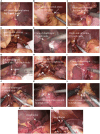Complete laparoscopic and Da Vinci robot esophagogastric anastomosis double muscle flap plasty for radical resection of proximal gastric cancer
- PMID: 38898957
- PMCID: PMC11186349
- DOI: 10.3389/fonc.2024.1395549
Complete laparoscopic and Da Vinci robot esophagogastric anastomosis double muscle flap plasty for radical resection of proximal gastric cancer
Abstract
Objective: To investigate the application value of complete laparoscopy and Da Vinci robot esophagogastric anastomosis double muscle flap plasty in radical resection of proximal gastric cancer.
Method: A retrospective descriptive study was used. The clinicopathological data of 35 patients undergoing radical operation for proximal gastric cancer admitted to Liaoning Cancer Hospital from January 2020 to December 2023 were collected. Variables evaluated: 1. Transoperative,2. Postoperative, 3. Follow-up. In relation to follow-up, esophageal disease status reflux, anastomosis, nutritional status score, serum hemoglobin, tumor recurrence, and metastasis were investigated. The trans and postoperative variables were obtained from the clinical records and the patients were followed up in outpatient department and by telephone.
Result: Among the 35 patients, 17 underwent robotic surgery and 18 underwent laparoscopic surgery. There were 29 males and 6 females. 1) Transoperative: Robotic surgery: The operation time was (305.59 ± 22.07) min, the esophagogastric anastomosis double muscle flap plasty time was (149.76 ± 14.91) min, the average number of lymph nodes cleared was 30, and the average intraoperative blood loss was 30 ml. Laparoscopic surgery: The mean operation time was 305.17 ± 26.92min, the operation time of esophagogastric anastomosis double muscle flap was (194.06 ± 22.52) min, the average number of lymph nodes cleared was 24, and the average intraoperative blood loss was 52.5 ml. 2) Postoperative: Robotic surgery: the average time for patients to have their first postoperative anal emission was 3 days, the average time to first postoperative feeding was 4 days, and the average length of hospitalization after surgery was 8 days. Laparoscopic surgery: the average time for patients to have their first postoperative anal emission was 5 days, the average time to first postoperative feeding was 6 days, the average length of hospitalization after surgery was 10 days. 3) Follow-up: The follow-up time ranged from 1 to 42 months, with a median follow-up time of 24 months.
Conclusion: Complete Da Vinci robot and laparoscopic esophagogastric anastomosis double muscle flap plasty for radical resection of proximal gastric cancer can minimize surgical incision, reduce abdominal exposure, accelerate postoperative recovery of patients, and effectively prevent reflux esophagitis and maintain good hemoglobin concentration and nutritional status. The advantages of robotic surgery is less intraoperative bleeding and faster post-surgical recovery, but it is relatively more expensive.
Keywords: Da Vinci robot; complications; kamikawa anastomosis; laparoscopy; radical resection of proximal gastric cancer; stomach neoplasms; upper stomach.
Copyright © 2024 Yang, Liu, Meng, Xu, Wang, Zhang and Zhang.
Conflict of interest statement
The authors declare that the research was conducted in the absence of any commercial or financial relationships that could be construed as a potential conflict of interest.
Figures





Similar articles
-
[Application of modified Kamikawa anastomosis in digestive tract reconstruction after proximal gastrectomy].Zhonghua Wei Chang Wai Ke Za Zhi. 2021 Aug 25;24(8):691-697. doi: 10.3760/cma.j.issn.441530-20201015-00559. Zhonghua Wei Chang Wai Ke Za Zhi. 2021. PMID: 34412186 Chinese.
-
[Safety and feasibility of laparoscopic double-flap technique in digestive tract reconstruction after proximal gastrectomy for esophagogastric junction tumors larger than 5 cm].Zhonghua Wei Chang Wai Ke Za Zhi. 2021 Feb 25;24(2):167-172. doi: 10.3760/cma.j.cn.441530-20200318-00153. Zhonghua Wei Chang Wai Ke Za Zhi. 2021. PMID: 33508923 Chinese.
-
[Short-term outcomes and long-term quality of life after undergoing radical proximal gastrectomy with esophageal gastric tube anastomosis and total gastrectomy with Roux-en-Y anastomosis for Siewert type II and III adenocarcinoma of the esophagogastric junction: A propensity score matching analysis].Zhonghua Wei Chang Wai Ke Za Zhi. 2023 Feb 25;26(2):181-190. doi: 10.3760/cma.j.cn441530-20220728-00330. Zhonghua Wei Chang Wai Ke Za Zhi. 2023. PMID: 36797565 Chinese.
-
[Preliminary experience with double-tract reconstruction combined with π-shaped esophagojejunal anastomosis after total laparoscopic proximal gastrectomy for the treatment of adenocarcinoma of esophagogastric junction].Zhonghua Wei Chang Wai Ke Za Zhi. 2022 May 25;25(5):440-446. doi: 10.3760/cma.j.cn441530-20210812-00327. Zhonghua Wei Chang Wai Ke Za Zhi. 2022. PMID: 35599399 Chinese.
-
[History and present situation of seromuscular flap anastomosis in proximal gastrectomy].Zhonghua Wei Chang Wai Ke Za Zhi. 2022 May 25;25(5):466-470. doi: 10.3760/cma.j.cn441530-20211019-00419. Zhonghua Wei Chang Wai Ke Za Zhi. 2022. PMID: 35599403 Review. Chinese.
Cited by
-
Comment on: Short-term outcomes of robotic versus laparoscopic gastrectomy for proximal gastric cancer: a systematic review and meta-analysis of propensity score-matched or baseline-balanced retrospective studies.J Robot Surg. 2025 Jul 14;19(1):387. doi: 10.1007/s11701-025-02569-x. J Robot Surg. 2025. PMID: 40658264 No abstract available.
-
Short-term outcomes of robotic versus laparoscopic gastrectomy for proximal gastric cancer: a systematic review and meta-analysis of propensity score-matched or baseline-balanced retrospective studies.J Robot Surg. 2025 Jun 23;19(1):318. doi: 10.1007/s11701-025-02415-0. J Robot Surg. 2025. PMID: 40549062
-
The Effect of Nutrition Impact Symptoms on Nutrition Status After Completion of Curative-Intent Treatment for Gastric, Oesophageal, and Pancreatic Cancer: A Systematic Review.Nutrients. 2025 Aug 20;17(16):2691. doi: 10.3390/nu17162691. Nutrients. 2025. PMID: 40871719 Free PMC article. Review.
References
-
- Suda K, Ishida Y, Kawamura Y, Inaba K, Kanaya S, Teramukai S, et al. . Robot-assisted thoracoscopic lymphadenectomy along the left recurrent laryngeal nerve for esophageal squamous cell carcinoma in the prone position: technical report and short-term outcomes. World J Surg. (2012) 36:1608–16. doi: 10.1007/s00268-012-1538-8 - DOI - PubMed
-
- Suda K, Man IM, Ishida Y, Kawamura Y, Satoh S, Uyama I. Potential advantages of robotic radical gastrectomy for gastric adenocarcinoma in comparison with conventional laparoscopic approach: A single institutional retrospective comparative cohort study. Surg Endosc. (2015) 29:673–85. doi: 10.1007/s00464-014-3718-0 - DOI - PubMed
LinkOut - more resources
Full Text Sources

